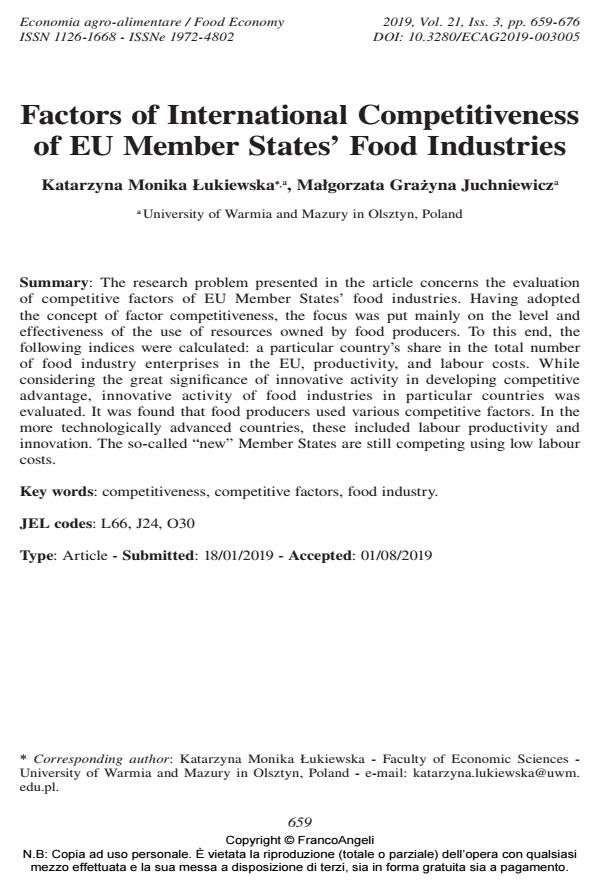Factors of International Competitiveness of EU Member States’ Food Industries
Titolo Rivista ECONOMIA AGRO-ALIMENTARE
Autori/Curatori Katarzyna Monika Lukiewska, Malgorzata Grazyna Juchniewicz
Anno di pubblicazione 2020 Fascicolo 2019/3 Lingua Inglese
Numero pagine 18 P. 659-676 Dimensione file 323 KB
DOI 10.3280/ECAG2019-003005
Il DOI è il codice a barre della proprietà intellettuale: per saperne di più
clicca qui
Qui sotto puoi vedere in anteprima la prima pagina di questo articolo.
Se questo articolo ti interessa, lo puoi acquistare (e scaricare in formato pdf) seguendo le facili indicazioni per acquistare il download credit. Acquista Download Credits per scaricare questo Articolo in formato PDF

FrancoAngeli è membro della Publishers International Linking Association, Inc (PILA)associazione indipendente e non profit per facilitare (attraverso i servizi tecnologici implementati da CrossRef.org) l’accesso degli studiosi ai contenuti digitali nelle pubblicazioni professionali e scientifiche
The research problem presented in the article concerns the evaluation of competitive factors of EU Member States’ food industries. Having adopted the concept of factor competitiveness, the focus was put mainly on the level and effectiveness of the use of resources owned by food producers. To this end, the following indices were calculated: a particular country’s share in the total number of food industry enterprises in the EU, productivity, and labour costs. While considering the great significance of innovative activity in developing competitive advantage, innovative activity of food industries in particular countries was evaluated. It was found that food producers used various competitive factors. In the more technologically advanced countries, these included labour productivity and innovation. The so-called "new" Member States are still competing using low labour costs.
Keywords:Competitiveness, competitive factors, food industry.
Jel codes:L66, J24, O30
- przedsiębiorstw przemysłu spożywczego. Zeszyty Naukowe Szkoły Głównej Gospodarstwa Wiejskiego w Warszawie, Problemy Rolnictwa Światowego, 7(22), 50-57.
- Bodirsky, B.L. Rolinski, S., Biewald, A., Weindl, I., Popp, A. & Lotze-Campen, H. (2015). Global Food Demand Scenarios for the 21st Century. Plos One, 10(11), e0139201.
- Chądrzyński, M. (2016). Innowacyjność przedsiębiorstw przemysłu spożywczego w Polsce. Roczniki Naukowe SERiA, XVIII(4), 31-36.
- Data & Trends UE Food & Drink Industry (2018). Fischer, C. & Schornberg S. (2006). The competitiveness situation of the EU meat processing and beverage manufacturing sectors. Acta Agriculturae Scandinavica Section C - Economy, 4(3), 1-20.
- Grzebyk, M. & Kryński, Z. (2011). Konkurencja i konkurencyjność przedsiębiorstw. Ujęcie teoretyczne. Nierówności Społeczne a Wzrost Gospodarczy, 20, 107-117.
- Hollensen, S. (2007). Global Marketing. Harlow: Pearson Education Limited. Hunt, S.D. & Morgan, R.M. (1995). The Comparative Advance Theory of Competition. Journal of Marketing, 95(2), 1-15.
- Juchniewicz, M. (2015). The level and diversity of innovativeness in food industry of European Union countries, Proceedings of mac-emm 2015 in Prague, October 2015, Prague, Czech Republic (pp. 1-7).
- Kaczorowska, J. (2009). Innowacyjna działalność produktowa polskich
- Kundrikova, J., Siantova, E. & Latka, M. (2016). Innovation process management within cooperation of companies. Proceedings of the 16th International Scientific Conference on Globalization and its Socio-Economic Consequences, Part 3.
- October 5-6, 2016, Zilina, Slovakia (pp. 1128-1135).
- Latruffe, L. (2010). Competitiveness, productivity and efficiency in the agricultural and agri-food sectors. oecd Food, Agriculture and Fisheries Papers, 30, oecd Publishing. -- Available at http://dx.doi.org/10.1787/5km91nkdt6d6-en.
- Łukiewska, K. & Juchniewicz, M. (2016). Produktywność jako czynnik konkurencyjności przemysłu spożywczego. In I. Szczepaniak (Ed.), Konkurencyjność polskich producentów żywności i jej determinanty (2), Seria „Program Wieloletni 2015-2019, IERiGŻ-PIB.
- Łukiewska, K. & Juchniewicz, M. (2017). Typology of innovativeness of food industry within EU countries in terms of globalization. Globalization and its socio-economic consequences: Proceedings of the 17th International Scientific Conference on Globalization and its Socio-Economic Consequences, October 4-5, 2017, Rajecke Teplice, Slovakia (pp. 1372-1379).
- Melitz, M. (2003). The impact of trade on intra-industry reallocations and aggregate industry productivity. Econometrica, 71(6), 1695-1725.
- Mikuła, A. (2017). Demograficzne uwarunkowania światowego i krajowego popytu na żywność w latach 2000-2015. In K. Świetlik (Ed.), Ewolucja światowego i krajowego popytu na żywność w kontekście zmian demograficznych I bezpieczeństwa żywnościowego, seria “Monografie Programu Wieloletniego 2015-2019”, 65 (pp. 17-49), IERiGŻ-PIB.
- Mroczek, R. & Tereszczuk, M. (2013). Wydajność pracy jako jeden z elementow decydujących o międzynarodowej konkurencyjności polskiego przemysłu spożywczego. Zeszyty Naukowe sggw w Warszawie, Problemy Rolnictwa Światowego, 13(28), 51-58.
- Olczyk, M. (2008). Konkurencyjność. Teoria i praktyka. Wydawnictwo CeDeWu. Oslo Manual: Guidelines for Collecting and Interpreting Innovation Data, 3rd Edition oecd (2005). European Commission.
- Paliderova, M. & Hraskova, D. (2016). Dimension of innovation in enterprises. Proceedings of the 16th International Scientific Conference on Globalization and its Socio-Economic Consequences, Part 4. October 5-6, 2016, Zilina, Slovakia (pp. 1613-1619).
- Pereira, E.T., Bento, J.P.C. & Priede, J. (2013). The Contribution of Technological Change on EU Exports. Procedia - Social and Behavioral Sciences, 99, 658-664.
- Poczta, W. & Beba, P. (2014). Rozwoj i rola polskiego przemysłu spożywczego w warunkach akcesji do Unii Europejskiej. Polityki Europejskie, Finanse I Marketing, 11(60), 7-18.
- Porter, M.E. (2001). Porter o konkurencji. Polskie Wydawnictwo Ekonomiczne.
- Siudek, T. & Drabarczyk, K. (2015). Teoretyczne i aplikacyjne aspekty konkurencyjności - przegląd literatury. Zeszyty Naukowe Szkoły Głównej Gospodarstwa Wiejskiego. Ekonomika i Organizacja Gospodarki Żywnościowej, 112, 137-153.
- Suchecki, B. & Lewandowska-Gwarda, K. (2010). Klasyfikacja, wizualizacja i grupowanie danych przestrzennych. In B. Suchecki (Ed.), Ekonometria przestrzenna. Metody i modele analizy danych przestrzennych. Wydawnictwo C.H. Beck w Warszawie.
- Toth, J. & Ferto, M. (2017). Innovation in the Hungarian food economy. Agric. Econ. - Czech, 63(1), 43-51. DOI: 10.17221/196/2015-AGRICECON
- Wojciak, M. (2002). Konkurencyjność działów produkcyjnych polskiej gospodarki. Wydawnictwo Akademii Ekonomicznej im. Karola Adamieckiego w Katowicach. Wijnands, J.H.M, Bremmers, H.J., Van Der Meulen, B.M.J & Poppe, K.J. (2008).
- An economic and legal assessment of the EU food industry’s competitiveness. Agribusiness, 24(4), 417-439.
- Wijnands, J.H.M. & Verhoog, D. (2016). Competitiveness of the EU food industry. Ex-post assessment of trade performance embedded in international economic theory. LEI Wageningen UR.
- Zielińska-Głębocka, A. (2003). Potencjał konkurencyjny polskiego przemysłu w warunkach integracji europejskiej. Wydawnictwo UG w Gdańsku.
Katarzyna Monika Lukiewska, Malgorzata Grazyna Juchniewicz, Factors of International Competitiveness of EU Member States’ Food Industries in "ECONOMIA AGRO-ALIMENTARE" 3/2019, pp 659-676, DOI: 10.3280/ECAG2019-003005